Related Research Articles

The Council of Chalcedon was the fourth ecumenical council of the Christian Church. It was convoked by the Roman emperor Marcian. The council convened in the city of Chalcedon, Bithynia from 8 October to 1 November 451. The council was attended by over 520 bishops or their representatives, making it the largest and best-documented of the first seven ecumenical councils. The principal purpose of the council was to re-assert the teachings of the ecumenical Council of Ephesus against the teachings of Eutyches and Nestorius. Such doctrines viewed Christ's divine and human natures as separate (Nestorianism) or viewed Christ as solely divine (monophysitism).
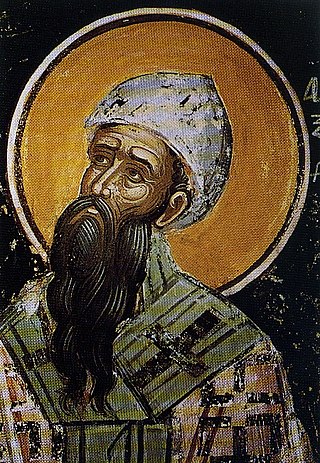
Cyril of Alexandria was the Patriarch of Alexandria from 412 to 444. He was enthroned when the city was at the height of its influence and power within the Roman Empire. Cyril wrote extensively and was a major player in the Christological controversies of the late-4th and 5th centuries. He was a central figure in the Council of Ephesus in 431, which led to the deposition of Nestorius as Patriarch of Constantinople. Cyril is counted among the Church Fathers and also as a Doctor of the Church, and his reputation within the Christian world has resulted in his titles Pillar of Faith and Seal of all the Fathers. The Nestorian bishops at their synod at the Council of Ephesus declared him a heretic, labelling him as a "monster, born and educated for the destruction of the church".
Nestorianism is a term used in Christian theology and Church history to refer to several mutually related but doctrinarily distinct sets of teachings. The first meaning of the term is related to the original teachings of Christian theologian Nestorius, who promoted specific doctrines in the fields of Christology and Mariology. The second meaning of the term is much wider, and relates to a set of later theological teachings, that were traditionally labeled as Nestorian, but differ from the teachings of Nestorius in origin, scope and terminology. The Oxford English Dictionary defines Nestorianism as:
"The doctrine of Nestorius, Patriarch of Constantinople, by which Christ is asserted to have had distinct human and divine persons."
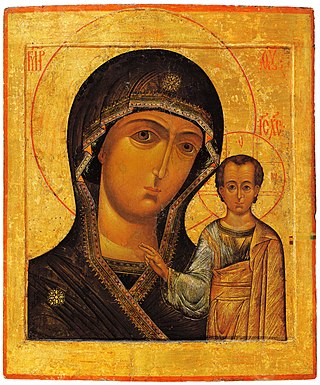
Theotokos is a title of Mary, mother of Jesus, used especially in Eastern Christianity. The usual Latin translations are Dei Genitrix or Deipara. Familiar English translations are "Mother of God" or "God-bearer" – but these both have different literal equivalents in Ancient Greek: Μήτηρ Θεοῦ, and Θεοφόρος respectively.

Theodoret of Cyrus or Cyrrhus was an influential theologian of the School of Antioch, biblical commentator, and Christian bishop of Cyrrhus (423–457).
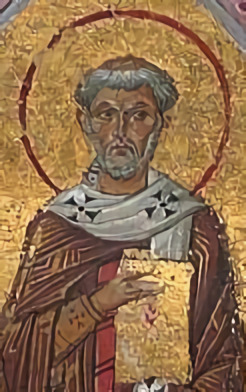
Pope Leo I, also known as Leo the Great, was Bishop of Rome from 29 September 440 until his death. He is the first of the three Popes listed in the Annuario Pontificio with the title "the Great", alongside Popes Gregory I and Nicholas I.

The Council of Ephesus was a council of Christian bishops convened in Ephesus in AD 431 by the Roman Emperor Theodosius II. This third ecumenical council, an effort to attain consensus in the church through an assembly representing all of Christendom, confirmed the original Nicene Creed, and condemned the teachings of Nestorius, Patriarch of Constantinople, who held that the Virgin Mary may be called the Christotokos, "Christ-bearer" but not the Theotokos, "God-bearer". It met from 22 June to 31 July 431 at the Church of Mary in Ephesus in Anatolia.

Nestorius was an early Christian prelate who served as Archbishop of Constantinople from 10 April 428 to August 431. A Christian theologian from the Catechetical School of Antioch, several of his teachings in the fields of Christology and Mariology were seen as controversial and caused major disputes.

Anatolius was a Patriarch of Constantinople. He is regarded as a saint, by both the Orthodox and Roman Catholic Churches.
Maximianus was the archbishop of Constantinople from 25 October 431 until his death on 12 April 434.
Dioscorus I, also known as Dioscorus the Great, was the pope of Alexandria and patriarch of the See of St. Mark who was deposed by the Council of Chalcedon in 451. He was recognized as patriarch by the Coptic Church until his death. He died in Gangra, Paphlagonia, in September 454. He is venerated as a saint by the Coptic and other Oriental Orthodox Churches.

The Catechetical School of Antioch was one of the two major Christian centers of the study of biblical exegesis and theology during Late Antiquity; the other was the School of Alexandria. This group was known by this name because the advocates of this tradition were based in the city of Antioch in Syria, one of the major cities of the ancient Roman Empire. Although there were early interpreters from Antioch, like Theophilus of Antioch, the proper school of exegesis at Antioch belongs to the period of the late fourth and the fifth centuries.

The Nestorian schism was a split between the Christian churches of Sassanid Persia, which affiliated with Nestorius, and those that later became the Catholic and Orthodox churches. The schism rose out of a Christological dispute, notably involving Cyril and Nestorius.
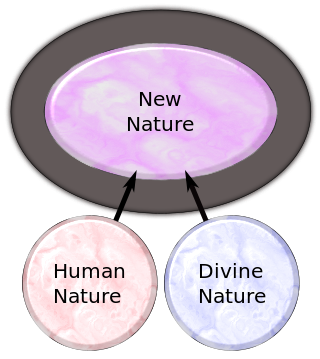
Eutychianism, also known as Real Monophysitism, refers to a set of Christian theological doctrines derived from the ideas of Eutyches of Constantinople. Eutychianism is a monophysite understanding of how the human and divine relate within the person of Jesus Christ, with Christ being in one nature and of two, with the humanity of Christ subsumed by the divinity.
The Second Council of Ephesus was a Christological church synod in 449 convened by Emperor Theodosius II under the presidency of Pope Dioscorus I of Alexandria. It was intended to be an ecumenical council, and it is accepted as such by the miaphysite churches but was rejected by Chalcedonian Christians. It was explicitly repudiated by the next council, the Council of Chalcedon of 451, recognised as the fourth ecumenical council by Chalcedonian Christians, and it was named the Latrocinium by Pope Leo I; the Chalcedonian churches, particularly the Roman Catholic and Eastern Orthodox communions, continue to accept this designation, while the Oriental Orthodox repudiate it.
Saint Juvenal was Bishop of Jerusalem from 422. On the See of Jerusalem being recognised as a Metropolitinate by the Council of Chalcedon, he became the first Metropolitan of Jerusalem, an office he occupied until his death in 458. His jurisdictional reach over all three provinces of Roman Palestine would subsequently gain him the recognition as the first Patriarch of Jerusalem.

Coptic history is the part of the history of Egypt that begins with the introduction of Christianity in Egypt in the 1st century AD during the Roman period, and covers the history of the Copts to the present day. Many of the historic items related to Coptic Christianity are on display in many museums around the world and a large number is in the Coptic Museum in Coptic Cairo.
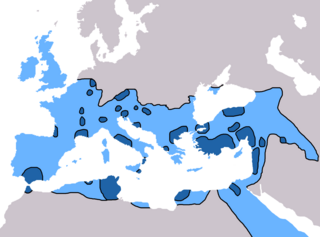
In the 5th century in Christianity, there were many developments which led to further fracturing of the State church of the Roman Empire. Emperor Theodosius II called two synods in Ephesus, one in 431 and one in 449, that addressed the teachings of Patriarch of Constantinople Nestorius and similar teachings. Nestorius had taught that Christ's divine and human nature were distinct persons, and hence Mary was the mother of Christ but not the mother of God. The Council rejected Nestorius' view causing many churches, centered on the School of Edessa, to a Nestorian break with the imperial church. Persecuted within the Roman Empire, many Nestorians fled to Persia and joined the Sassanid Church thereby making it a center of Nestorianism. By the end of the 5th century, the global Christian population was estimated at 10-11 million. In 451 the Council of Chalcedon was held to clarify the issue further. The council ultimately stated that Christ's divine and human nature were separate but both part of a single entity, a viewpoint rejected by many churches who called themselves miaphysites. The resulting schism created a communion of churches, including the Armenian, Syrian, and Egyptian churches, that is today known as Oriental Orthodoxy. In spite of these schisms, however, the imperial church still came to represent the majority of Christians within the Roman Empire.
The position of the Eastern Orthodox Church regarding the Filioque controversy is defined by their interpretation of the Bible, and the teachings of the Church Fathers, creeds and definitions of the seven Ecumenical Councils, as well as the decisions of several particular councils of the Eastern Orthodox Church.
Andreas was a bishop of Samosata about 430 CE. He took part in the Nestorian controversy against Cyril, Patriarch of Alexandria, in answer to whose anathemas he wrote two books, of the first of which a large part is quoted by Cyril, in his Apol. adv. Orientales, and of the second some fragments are contained in the Hodegus of Anastasius Sinaita. Though prevented by illness from being present at the Council of Ephesus, he joined Theodoret in his opposition to the agreement between Cyril and John of Antioch, and, like Theodoret, he changed his course, but at a much earlier period. Modern scholars credit him with the being the most active mediator between the two sides of the conflict, having an essentially centrist stance but ultimately flip-flopping in his position considerably.
References
- ↑ Alexandria), Saint Cyril (Patriarch of; Russell, Norman (2000). Cyril of Alexandria. Psychology Press. ISBN 978-0-415-18251-5.
- ↑ "ORTHODOX AND ORIENTAL ORTHODOX CONSULTATION". www.romanity.org. Retrieved 2024-09-26.
- ↑ "Anathema (431AD Ephesus) Translation". patristica.net.
- ↑ Cyril of Alexandria (1900) [431]. Schaff, Philip; Wace, Henry (eds.). Nicene and Post-Nicene Fathers, Second Series, Vol. 14. Translated by Percival, Henry. Buffalo, NY: Christian Literature Publishing Co. ISBN 978-1602065338.